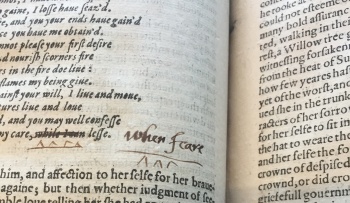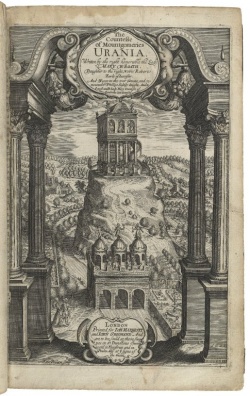The Countess of Montgomery's Urania: Difference between revisions
SophieByvik (talk | contribs) No edit summary |
SophieByvik (talk | contribs) (manuscript continuation, added title page image) |
||
| Line 7: | Line 7: | ||
Lady Mary Wroth (neé Sidney) was born October 18, c. 1587, into a literary family. Her uncle Sir Philip Sidney wrote the prose romance ''The Countess of Pembroke's Arcadia'' and the sonnet sequence ''Astrophel and Stella'', and her aunt Mary Sidney was known for her poetic translations of the Psalms; her father Robert also wrote poetry and circulated it in manuscript among family and friends. She married Sir Robert Wroth (c.1576–1614) on September 27, 1604. About month before his death on March 41, 1614, Wroth gave birth to a son, James. James followed his father to the grave two years later on July 5, 1616, and Wroth was left to manage mounting debts. | Lady Mary Wroth (neé Sidney) was born October 18, c. 1587, into a literary family. Her uncle Sir Philip Sidney wrote the prose romance ''The Countess of Pembroke's Arcadia'' and the sonnet sequence ''Astrophel and Stella'', and her aunt Mary Sidney was known for her poetic translations of the Psalms; her father Robert also wrote poetry and circulated it in manuscript among family and friends. She married Sir Robert Wroth (c.1576–1614) on September 27, 1604. About month before his death on March 41, 1614, Wroth gave birth to a son, James. James followed his father to the grave two years later on July 5, 1616, and Wroth was left to manage mounting debts. | ||
Early in her widowhood, Wroth bore two children, Katherine and William, to her cousin William Herbert, 3rd Earl of Pembroke, with whom she was involved for some time. Around this time, between 1615 and 1620, Wroth probably began composing the first volume of ''The Countess of Montgomery's Urania''.<ref>Margaret P. Hannay, Mary Sidney, Lady Wroth (Farnham, Surrey, England: Ashgate, 2010), 230.</ref> She also began writing her sonnet sequence [http://hamnet.folger.edu/cgi-bin/Pwebrecon.cgi?BBID=233141 ''Pamphilia to Amphilanthus''] during this period, and nineteen of its poems are dispersed throughout the 1621 published edition of ''Urania''. After 1621, Wroth wrote a second volume of ''Urania'', which was never published during her lifetime. Its manuscript is currently held by the [https://i-share.carli.illinois.edu/nby/cgi-bin/Pwebrecon.cgi?DB=local&v1=1&BBRecID=792075 Newberry Library]. After the publication of ''Urania'', records of Wroth's life are sparse and largely occupied with her debt management, and she probably retreated from court and public life until her death in 1651 or 1653.<ref>Lamb, Mary Ellen. "Mary Wroth." Mary Wroth. January 2008. http://www.oxforddnb.com/view/article/30082.</ref> | Early in her widowhood, Wroth bore two children, Katherine and William, to her cousin William Herbert, 3rd Earl of Pembroke, with whom she was involved for some time. Wroth figures Herbert in her work as the unfaithful Amphilanthus, with whom the constant Pamphilia, representing Wroth, is paired. Around this time, between 1615 and 1620, Wroth probably began composing the first volume of ''The Countess of Montgomery's Urania''.<ref>Margaret P. Hannay, Mary Sidney, Lady Wroth (Farnham, Surrey, England: Ashgate, 2010), 230.</ref> She also began writing her sonnet sequence [http://hamnet.folger.edu/cgi-bin/Pwebrecon.cgi?BBID=233141 ''Pamphilia to Amphilanthus''] during this period, and nineteen of its poems are dispersed throughout the 1621 published edition of ''Urania''. After 1621, Wroth wrote a second volume of ''Urania'', which was never published during her lifetime. Its manuscript is currently held by the [https://i-share.carli.illinois.edu/nby/cgi-bin/Pwebrecon.cgi?DB=local&v1=1&BBRecID=792075 Newberry Library]. After the publication of ''Urania'', records of Wroth's life are sparse and largely occupied with her debt management, and she probably retreated from court and public life until her death in 1651 or 1653.<ref>Lamb, Mary Ellen. "Mary Wroth." Mary Wroth. January 2008. http://www.oxforddnb.com/view/article/30082.</ref> | ||
==Publication history== | ==Publication history== | ||
Revision as of 21:33, 1 December 2015
The Countess of Montgomery's Urania (also The Countesse of Mountgomeries Urania), published in 1621, is a prose romance written by Lady Mary Wroth (c. 1587–1651/3). The romance's most notable storyline centers upon the romance between the faithful Pamphilia and the roving Amphilanthus; it also follows a myriad of other noble and non-noble characters across a fictional Europe. As the earliest prose romance written by a woman in English, the novel's publication challenged established 17th-century aristocratic conceptions of female virtue, which was considered compromised if a woman's work appeared in print.
Author's biography
Lady Mary Wroth (neé Sidney) was born October 18, c. 1587, into a literary family. Her uncle Sir Philip Sidney wrote the prose romance The Countess of Pembroke's Arcadia and the sonnet sequence Astrophel and Stella, and her aunt Mary Sidney was known for her poetic translations of the Psalms; her father Robert also wrote poetry and circulated it in manuscript among family and friends. She married Sir Robert Wroth (c.1576–1614) on September 27, 1604. About month before his death on March 41, 1614, Wroth gave birth to a son, James. James followed his father to the grave two years later on July 5, 1616, and Wroth was left to manage mounting debts.
Early in her widowhood, Wroth bore two children, Katherine and William, to her cousin William Herbert, 3rd Earl of Pembroke, with whom she was involved for some time. Wroth figures Herbert in her work as the unfaithful Amphilanthus, with whom the constant Pamphilia, representing Wroth, is paired. Around this time, between 1615 and 1620, Wroth probably began composing the first volume of The Countess of Montgomery's Urania.[1] She also began writing her sonnet sequence Pamphilia to Amphilanthus during this period, and nineteen of its poems are dispersed throughout the 1621 published edition of Urania. After 1621, Wroth wrote a second volume of Urania, which was never published during her lifetime. Its manuscript is currently held by the Newberry Library. After the publication of Urania, records of Wroth's life are sparse and largely occupied with her debt management, and she probably retreated from court and public life until her death in 1651 or 1653.[2]
Publication history

Urania was entered into the Stationers' Register on July 13, 1621 by John Marriott and John Grismand.[3] The work may have been sold at Grismand's shop in Paul's Cross Churchyard, under the sign of the Gun, which was used by Grismand from 1618 to 1626.[4] It was printed by Augustine Matthews, whose work has been identified through his typeface and use of printer's ornaments, which Matthews borrowed from fellow printer Felix Kingston. Parts of the book also may have been printed by Matthews' partner John White.[5]The romance is known for its midsentence ending, which seemed to confuse Matthews. Urania's first volume is divided into four parts, and Matthews ends the first three parts with a printer's ornament and a line in italic type announcing "the end of the first Booke," etc.[6]
Simon van de Passe engraved the title page, noted by the inscription "Sime [?] Passæus sculp" at its bottom left. van de Passe had painted several portraits of members of Wroth's relatives, including her aunt Mary Sidney, the Countess of Pembroke. The illustration, which depicts one of the kingdoms featured in the romance, is unusual for its time in its content-specific nature. The title page's design and dedication resemble those of the Arcadia, and may signal Wroth's attempt to insert herself into the family literary canon.[7]
Wroth's involvement

It is not known whether Wroth either knew about or gave permission for the publication of Urania. However, Wroth probably knew of Urania's publication before it was printed, though there is no record of her explicitly permitting it. While Marriott and Grismand may have acquired a copy of Wroth's manuscript, it is possible that Wroth circulated her manuscript among her friends and family in the hope that it would be clandestinely distributed to a publisher. Circulating Urania in this manner would allow it to be published while avoiding the stigma of having her work in print.[8] Wroth also had loose connection to Marriott and Grismand through her cousin William Herbert, 3rd Earl of Pembroke. Herbert patronized poet and satirist George Wither, whose Wither's motto was published by Marriott and printed by Matthews in 1621.[9] Additionally, in a letter to George Villiers, 1st Duke of of Buckingham and favorite of James I, Wroth does not deny knowing about Urania's publication. She also made some textual corrections to her own copy of the novel, currently in the collection of the University of Pennsylvania, which indicates that Wroth was invested, in some level, in the appearance of her work in print.
Manuscript continuation
Wroth began composing a second volume of Urania between 1620 and 1630. The holograph manuscript, now in the collection of the Newberry Library, contains a variety of corrections and additions, which indicate that this is a working copy. Though the manuscript ends midsentence, a lack of concluding marks, incomplete plot lines, and blank spaces for character names also indicate that this copy of the manuscript is not final. A bifolio is missing from the manuscript, eliminating part of Amphilanthus' storyline. It was likely removed after the completion of the manuscript, either by Wroth herself or William Herbert based on potentially incriminating content – the missing section may have included the consummation of the relationship between Pamphilia and Amphilanthus, which would obliquely confirm the relationship between the cousins.
Subsequent editions
After 1621, no edition of Urania was published until the late 20th century. Josephine Roberts edited a scholarly edition printed in 1995. The first printed edition of the manuscript continuation, edited by Roberts, Suzanne Gossett, and Janel Mueller followed in 1999.
Urania and the Folger
The Folger holds two of twenty-nine existing copies of Urania. The library acquired the first of its copies (STC 26051 Copy 1) in 1938 with the purchase of the Harmsworth collection. The earliest known owner of this copy was one Ann Morris, who inscribed a prayer on the front flyleaf: The Lord of Heaven vpon her Look But when her passing bell doth toul The Lord of heaven recive her soul Amen 1723. By 1725, a Roger Jones owned the volume, as identified by another inscription on the flyleaf. Another owner, David Phillip, inscribed his name on the back flyleaf. The Folger's second copy (STC 26051 Copy 2) contains inscription on the front paste-down describing a debt: 26. Iunij 1635. At ye returne of this Booke I will repay 4s 6d [per] me Ellis Morgan. By the 20th century, the second copy entered the collection held at Lowther Castle in Westmorland, and was sold from there at auction to the Folger in July 1937.
Notes
- ↑ Margaret P. Hannay, Mary Sidney, Lady Wroth (Farnham, Surrey, England: Ashgate, 2010), 230.
- ↑ Lamb, Mary Ellen. "Mary Wroth." Mary Wroth. January 2008. http://www.oxforddnb.com/view/article/30082.
- ↑ "The Countesse of Montgomeries Urania," English Short Title Catalogue, http://estc.bl.uk/S122291.
- ↑ Blayney, Peter W. M. The Bookshops in Paul's Cross Churchyard. London: Bibliographical Society, 1990, 87-89.
- ↑ Roberts, The First Part of the Countess of Montgomery's Urania, cvii-cx.
- ↑ Roberts, The First Part of the Countess of Montgomery's Urania, cvii-cx.
- ↑ Hannay 233.
- ↑ Roberts, The First Part of the Countess of Montgomeries Urania, cv.
- ↑ Roberts, The First Part of the Countess of Montgomery's Urania, cvii-cx. In early 1621, Marriott and Grismand published Wither’s motto. Nec habeo, nec careo, nec curo, also printed by Matthews. On June 4 of that year, the three were fined for its publication, and spent some time in Marshalsea Prison, along with Wither. They were released on July 10, three days before Marriott and Grismand entered Urania into the Stationers' Register.